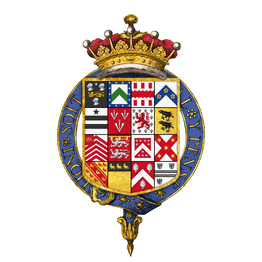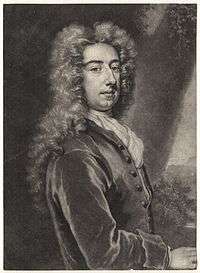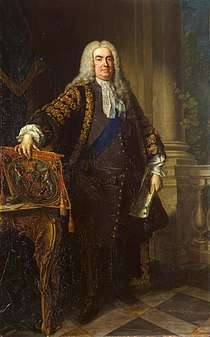Spencer Compton, 1st Earl of Wilmington
Spencer Compton, 1st Earl of Wilmington, KG, PC (c. 1674 – 2 July 1743)[1] was a British Whig statesman who served continuously in government from 1715 until his death. He sat in the English and British House of Commons between 1698 and 1728, and was then raised to the peerage and sat in the House of Lords. He served as the Prime Minister from 1742 until his death in 1743. He is considered to have been Britain's second Prime Minister, after Sir Robert Walpole, but worked closely with the Secretary of State, Lord Carteret, in order to secure the support of the various factions making up the Government.
The Earl of Wilmington KG PC | |
|---|---|
 Wilmington, ca. 1710. | |
| Prime Minister of Great Britain | |
| In office 16 February 1742 – 2 July 1743 | |
| Monarch | George II |
| Preceded by | Robert Walpole |
| Succeeded by | Henry Pelham |
| Lord President of the Council | |
| In office 31 December 1730 – 13 February 1742 | |
| Monarch | George II |
| Prime Minister | The Earl of Orford |
| Preceded by | Lord Trevor |
| Succeeded by | The Earl of Harrington |
| Personal details | |
| Born | c. 1674 Compton Wynyates, Warwickshire, England |
| Died | 2 July 1743 (aged 70) St James's, Middlesex, England |
| Political party | Whig |
| Parents | James Compton, 3rd Earl of Northampton Mary Noel |
| Alma mater | Trinity College, Oxford |
| Signature | |
Early life
Compton was the third son of the 3rd Earl of Northampton and his wife Mary Noel, daughter of Baptist Noel, 3rd Viscount Campden. He was educated at St Paul's and matriculated at Trinity College, Oxford on 28 February 1690, aged 15.[2] Thereafter he was admitted into Middle Temple in 1687.
Political career
English House of Commons
Although his family were High Tories, Compton turned to the Whigs after a quarrel with his brother, the 4th Earl of Northampton. He first stood for Parliament at East Grinstead on the interest of his kinsman the Earl of Dorset at the 1695 English general election but was unsuccessful. He was returned unopposed as Member of Parliament for Eye at a by-election on 3 June 1698. In Parliament he soon stood out as prominent amongst the Whigs and began a partnership with Robert Walpole that would last for over forty years. He was returned unopposed for Eye at the two general elections of 1701 and in 1702 and 1705.[3]
Paymaster of Pensions

In 1707 Compton became Paymaster of Pensions, a post that he retained for the next six years. He was returned unopposed again at the 1708 British general election and was particularly active in Parliament thereafter. He remained as chairman of the committee of privileges and elections, and was a teller on the Whig side in many divisions. He managed several bills and on 14 December 1709 was nominated to the committee to draw up the articles of impeachment against Dr Sacheverell. At the 1710 British general election he was dropped as a candidate for Eye by his patron Lord Cornwallis after a disagreement, and he was unwilling to risk standing anywhere else because of his involvement with the Sacheverell case. However he retained his post as Paymaster of Pensions after the Tory government took office in that year. It is believed that the Tories retained him because they sought to maintain the support of the Compton family. At the 1713 British general election he was returned as Whig MP for East Grinstead and when the Whigs took power in 1715 he was hopeful that he would enter a high office.[3]
Speaker of the Commons
Instead of the high political office he had hoped for, Compton received the Court appointment of Treasurer to the Prince of Wales (later George II); shortly afterwards, however, he was unanimously elected as Speaker of the House of Commons. He held this post from 1715 to 1727. In 1716, he was invested a Privy Counsellor. He maintained the role of Speaker despite the split in the Whigs in 1717, in which he joined the Walpole-Townshend alliance and found himself in opposition to the government of the day. He managed to maintain his position though until 1720, when the split ended.[4]
Compton had a reputation for being a lax Speaker, once telling an MP who complained of being interrupted, "No sir, you have a right to speak, but the House have a right to judge whether they will hear you."

When Walpole became the leading minister of the day in 1721 there was speculation about his future should George I pass away and be succeeded by his son, who was more favourably inclined towards Compton than Walpole and declared that he would replace the latter with the former on accession. In order to avoid this, Walpole sought to keep Compton on the margins of government, though he was appointed as Paymaster of the Forces, a very lucrative post, from 1722 until 1730. In 1725, Compton entered Walpole's government as Lord Privy Seal and was also created a Knight of the Bath.[4]
Missed chance
In 1727, George II succeeded to the throne and sought to bring about the change in leadership he had promised. However, Compton was not perceived as a man of great ability. He was described by a contemporary as "a plodding, heavy fellow, with great application but no talents". In particular he proved unable to compete with Walpole's proposals for an allowance for the King. At a meeting between the three, Compton declared he was not up to the task of government. He maintained a hatred of Walpole for the humiliation. With this passed his last serious chance of holding real control over policy, and his influence sharply declined as a result. He remained on very close terms with George, but the era when Kings could personally select their own ministers in defiance of parliament was ending.
House of Lords and Patriot Whigs
In order to remove him from the Commons, Walpole raised Compton to the peerage as Baron Wilmington, of Wilmington in the County of Sussex on 8 January 1728;[5] two years later, on 14 May 1730, he was created Viscount Pevensey, of Pevensey in the County of Sussex and Earl of Wilmington[6] and was appointed Lord President of the Council in December of that year. He became increasingly associated with the Patriot Whigs, those most critical of Walpole, but in Parliament generally stuck to the official line of the ministry. In 1730 he attempted to form a coalition between the Patriot Whigs and the Hanoverian Tories to bring down Walpole, but this failed and he continued in office.[7] However, during the Excise Crisis of 1733, he failed to carry through a threat to resign, after being bought off with the promise to make him a Knight of the Garter, which he duly was. This further weakened any following he still commanded. He served as Lord President until 1742.
He was involved in the creation of the Foundling Hospital in 1739, which was an orphanage for abandoned children. This charity became the capital's most fashionable way to prove one's philanthropic credentials and therefore had very notable board members, of whom Wilmington was one.
Prime Minister
In January 1742 he succeeded Walpole as First Lord of the Treasury and head of the Carteret ministry. Wilmington was a forceful Prime Minister, and grew notorious amongst his cabinet for taking measures without reaching consensus. His strong work ethic took its toll, and his health gradually deteriorated. He remained in office until his death, when he was succeeded by the Paymaster of the Forces, Henry Pelham.
Private life
.jpg)
He bought the East Borne estate in Eastbourne, Sussex in 1724 and renamed it Compton Place. He engaged the architect Colen Campbell (and after Campbell's death William Kent) to rebuild the house. It was completed in 1731.
Wilmington died unmarried and without issue, and therefore all his titles became extinct upon his death. Over 1110 items from his "large and valuable library" were auctioned by Christopher Cock over 10 evenings, from to 27 February to 7 March 1733.[8]
He was buried at his family seat of Compton Wynyates in Warwickshire.[1] Compton Place passed to his nephew, James Compton, 5th Earl of Northampton.
Legacy
The cities of Wilmington, Delaware and Wilmington, North Carolina, the towns of Wilmington, Massachusetts and Wilmington, Vermont, and, secondarily, the neighbourhood of Wilmington, Los Angeles,[9] are named in his honour. In Wilmington DE the Compton Towers housing project also bears his name.[10]
He never married. His brothers both have descendants in the United States and Great Britain. He was the first Prime Minister to die in office.
References
- Hanham, A. A. "Compton, Spencer, earl of Wilmington". Oxford Dictionary of National Biography (online ed.). Oxford University Press. doi:10.1093/ref:odnb/6036. (Subscription or UK public library membership required.)
- Foster, Joseph. "Colericke-Coverley in Alumni Oxonienses 1500-1714 pp. 304-337". British History Online. Retrieved 20 June 2019.
- "COMPTON, Hon. Spencer (c.1674-1743), of Compton Place, Eastbourne, Suss". History of Parliament Online (1690-1715). Retrieved 20 February 2019.
- "COMPTON, Hon. Spencer (?1674-1743), of Compton Place, Eastbourne, Suss". History of Parliament Online (1715-1754). Retrieved 20 June 2019.
- "No. 6638". The London Gazette. 6 January 1728. p. 2.
- "No. 6881". The London Gazette. 12 May 1730. p. 1.
- Black p.69
- Cock, Christopher (1733). A catalogue of the large and valuable library of the Right Honourable Spencer, Earl of Wilmington, lately deceas'd. Consisting of a collection of ... London: Christopher Cock.
- Named in 1863 to commemorate the founder's birthplace.
- "Compton Towers". Wilmington Housing Authority. Archived from the original on 25 June 2008. Retrieved 26 September 2008.
- Burke's Peerage
- . Dictionary of National Biography. London: Smith, Elder & Co. 1885–1900.
Bibliography
- Jeremy Black. British Politics and Foreign Policy, 1727-44. Ashgate Publishing, 2014.
- Browning, Reed. The Duke of Newcastle. Yale University Press, 1975.
- Field, Ophelia. The Kit-Cat Club: Friends who Imagined a Nation. Harper Collins, 2008.
- Pearce, Eward. The Great Man: Sir Robert Walpole. Pimlico, 2008.
- Simms, Brendan. Three Victories and a Defeat: The Rise and Fall of the First British Empire. Penguin Books, 2008.
External links
- Spencer Compton, 1st Earl of Wilmington at Find a Grave
- More about Spencer Compton, Earl of Wilmington on the Downing Street website.
| Political offices | ||
|---|---|---|
| Preceded by Thomas Hanmer |
Speaker of the House of Commons of Great Britain 1715–1727 |
Succeeded by Arthur Onslow |
| Preceded by The Lord Cornwallis |
Paymaster of the Forces 1722–1730 |
Succeeded by Henry Pelham |
| Preceded by The Lord Trevor |
Lord Privy Seal 1730 |
In commission Title next held by The Duke of Devonshire |
| Lord President of the Council 1730–1742 |
Succeeded by The Earl of Harrington | |
| Preceded by The Earl of Orford |
Prime Minister of Great Britain 16 February 1742 – 2 July 1743 |
Succeeded by Henry Pelham |
| First Lord of the Treasury 1742–1743 | ||
| Parliament of Great Britain | ||
| Preceded by Charles Cornwallis Sir Joseph Jekyll |
Member of Parliament for Eye 1698–1710 Served alongside: Sir Joseph Jekyll |
Succeeded by Thomas Maynard Sir Joseph Jekyll |
| Preceded by John Conyers Leonard Gale (MP) |
Member of Parliament for East Grinstead 1713–1715 Served alongside: John Conyers |
Succeeded by John Conyers The Viscount Shannon |
| Preceded by Henry Campion John Fuller |
Member of Parliament for Sussex 1715–1728 With: James Butler 1715–1722 Henry Pelham 1722–1728 |
Succeeded by Henry Pelham James Butler |
| Preceded by John Conyers The Viscount Shannon |
Member of Parliament for East Grinstead 1722 Served alongside: John Conyers |
Succeeded by John Conyers The Viscount Shannon |
| Records | ||
| Preceded by The Earl of Orford |
Oldest living Prime Minister of Great Britain 1742–1743 |
Succeeded by The Earl of Orford |
| Peerage of Great Britain | ||
| New creation | Earl of Wilmington 1730–1743 |
Extinct |
| Baron Wilmington 1728–1743 | ||
| Records | ||
| Preceded by The Earl of Orford |
Oldest Living Prime Minister 1742–1743 |
Succeeded by The Earl of Orford |
.svg.png)

.jpg)